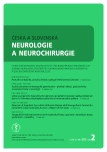Guideline for the Diagnosis and Therapy of Myasthenia Gravis
Authors:
J. Piťhaα 1 *; J. Bednařík 2*; O. Zapletalová 3*; J. Schützner 4**; J. Zámečník 5**; Z. Ambler 6***; M. Pátá 7****; M. Suchý 7****
Authors‘ workplace:
autor
*; konzultant
**; oponent
***; člen vývojového týmu
****; Vedoucí lékař Centra pro léčbu myasthenia gravis Neurologické kliniky 1. LF UK a VFN v Praze, Člen výboru Sekce neuroimunologie a likvorologie (SNIL), člen Neuromuskulární sekce (NMS) České neurologické společnosti (ČNS) ČLS JEP
1; Člen výboru NMS a místopředseda ČNS ČLS JEP
2; Členka výboru SNIL ČNS ČLS JEP
3; Předseda Sekce hrudní chirurgie České chirurgické společnosti ČLS JEP
4; Společnost českých patologů ČLS JEP
5; Člen výboru NMS ČNS ČLS JEP
6; Národní referenční centrum Praha
αgarant
7
Published in:
Cesk Slov Neurol N 2012; 75/108(2): 242-252
Category:
Guidelines
Overview
The Czech Neurological Society taskforce in collaboration with other professionals has developed a clinical standard for the diagnosis and treatment of myasthenia gravis. The development of the standard was prompted by the need to unify the diagnosis and treatment of myasthenia gravis, to monitor side and adverse effects of modern drugs and to verify their effectiveness, to monitor the effectiveness of care and to ensure efficient use of resources and diagnostic and therapeutic efforts in order to improve the quality of care provided. Key recommendations are based on the international guidelines, formulated by the EFNS [2] and the Euromyasthenia panel (2008) [3]. The level of evidence for all recommendations was classified according to the EFNS classification by Brainin et al [4].
Key words:
myasthenia gravis – key recommendations – diagnosis – treatment – centralized care
Sources
1. McGrogan A, Sneddon S, de Vries CS. The incidence of myasthenia gravis: a systematic literature review. Neuroepidemiology 2010; 34(3): 171–183.
2. Skeile GO, Apostolski S, Evoli A, Gilhus NE, Illa I, Harms L et al. Guidelines for treatment of autoimmune neuromuscular transmission disorders. Eur J Neurol 2010; 17(7): 893–902.
3. Vincent A. The recommendations were prepared taking into account feedback from D Hilton-Jones in Oxford and some of our partners. Myasthenia Gravis: Clinical guidelines, 2008. Available from: http://www.euromyasthenia.org.
4. Brainin M, Barnes M, Baron JC, Gilhus NE, Hughes R, Selmaj K et al. Guidance for the preparation of neurological management guidelines by EFNS scientific task forces – revised recommendations 2004. Eur J Neurol 2004; 11(9): 577–581.
5. Kaminski HJ. Myasthenia gravis and related disorders. 2nd ed. New York: Humana Press 2009: 577–581.
6. Kupersmith MJ, Ying G. Ocular motor dysfunction and ptosis in ocular myasthenia gravis: effects of treatment. Br J Ophthalmol 2005; 89(10): 1330–1334.
7. Piťha J et al. Myasthenia gravis a ostatní poruchy nervosvalového přenosu. Praha: Maxdorf 2010.
8. Sanders DB. Generalised myasthenia gravis: Clinical presentation and diagnosis. In: Kaminski HJ (ed). Myasthenia gravis: diagnosis and Treatment. Education program syllabus American Academy of Neurology. 56th Anual Meeting. San Franscisco 2004: 10–17.
9. Guptill JT, Sanders DB. Update on muscle-specific tyrosine kinase antibody positive myasthenia gravis. Curr Opin Neurol 2010; 23(5): 530–535.
10. Shah AK. Myasthenia Gravis. Available from: http://emedicine.medscape.com/article/1171206-overview.
11. Špalek P. Myasténia gravis. Cesk Slov Neurol N 2008; 71/104(1): 7–24.
12. Piťha J, Matějková E. Asociace HLA antigenů s myasthenia gravis u české populace. Cesk Slov Neurol N 1998; 61/94(1): 7–12.
13. Angelini C. Diagnosis and management of autoimmune myasthenia gravis. Clin Drug Investig 2011; 31(1): 1–14.
14. Ambler Z. Neurofyziologie a elektrodiagnostika nervosvalového přenosu. Neurol pro Praxi 2010; 11(2): 81–84.
15. Oh SJ. Electromyography: neuromuscular transmission studies. Baltimore: Williams & Wilkins 1988.
16. Sanders DB, Howard JF Jr. AAEE minimonograph #25: Single-fiber electromyography in myasthenia gravis. Muscle Nerve 1986; 9(9): 809–819.
17. Stalberg E, Trontelj JV. Single Fiber Electromyography. Studies in Healthy and Diseased Muscle. New York: Raven Press 1994.
18. Trontelj JV, Mihelin M, Fernandez JM, Stålberg E. Axonal stimulation for end-plate jitter studies. J Neurol Neurosurg Psychiatry 1986; 49(6): 677–685.
19. Mantegazza R, Bonanno S, Camera G, Antozzi C. Current and emerging therapies for the treatment of myasthenia gravis. Neuropsychiatric Dis Treat 2011; 7: 151–160.
20. Pearson FG, Deslauriers J, Ginsberg RJ, Hiebert CA, McKneally MF, Urschel HC et al. Thoracic surgery. New York: Churchill Livingston 1995.
21. Gagner M, Inabnet WB 3rd. Minimally invasive endocrine surgery. Philadelphia: Lippincot Williams and Wilkins 2002.
22. Shields TW. Mediastinal surgery. Philadelphia, London: Lea and Febiger 1991.
23. Minami N, Fujiki N, Doi S, Shimab K, Niino M, Kikuchi S et al. Five-year follow-up with low-dose tacrolimus in patients with myasthenia gravis. J Neurol Sci 2011; 300(1–2): 59–62.
24. Blaha M, Pit’ha J, Blaha V, Lanska M, Maly J, Filip S et al. Extracorporeal immunoglobulin elimination for the treatment of severe myasthenia gravis. J Biomed Biotechnol 2010; 2010: 419520.
25. Auriel E, Regev K, Dori A, Karni A. Safety of influenza and H1N1 vaccinations in patients with myasthenia gravis, and patient compliance. Muscle Nerve 2011; 43(6): 893–894.
Labels
Paediatric neurology Neurosurgery NeurologyArticle was published in
Czech and Slovak Neurology and Neurosurgery

2012 Issue 2
- Metamizole vs. Tramadol in Postoperative Analgesia
- Memantine in Dementia Therapy – Current Findings and Possible Future Applications
- Memantine Eases Daily Life for Patients and Caregivers
- Metamizole at a Glance and in Practice – Effective Non-Opioid Analgesic for All Ages
- Advances in the Treatment of Myasthenia Gravis on the Horizon
Most read in this issue
- The Use of Percutaneous Endoscopic Gastrostomy – Overview of Indications, Description of the Technique and Current Trends in Neurology
- Postural Instability, Gait Disorders and Falls in Parkinson’s Disease
- The Algorithm of CSF Examination according to the Reccomendation of the Committee of CSF and Neuroimmunology of the Czech Neurological Society
- Obstructive Sleep Apnoe and CPAP – is it Reasonable to Solve Nasal Patency?
